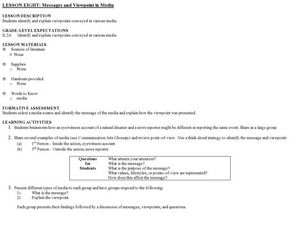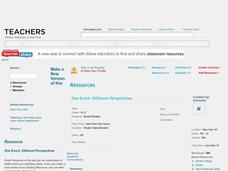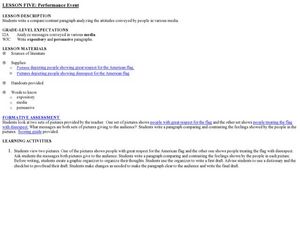Media Smarts
Taking Charge of TV Violence
Encourage your class to become aware of the violence that is present in children's television programs and how this violence can influence children. Do this by holding the planned class discussion in this lesson plan and providing...
Media Smarts
Bias
See how bias operates firsthand. Half of the class reads one article while the other half reads another article on the same event. The obvious differences emerge when the two sides talk about their observations though. Several handouts...
Media Smarts
Hoax? Scholarly Research? Personal Opinion?
Divide your class into groups to study the validity of online sources. One group looks at the authority and accuracy of four listed websites, another group looks at advocacy and objectivity, and the third group looks at currency and...
Media Smarts
Selling Tobacco
Take a look at tobacco advertising techniques through the decades. Students analyze the differences in strategies, and write an essay on the advertising history of one brand of tobacco, how tobacco advertising has changed over time, or...
Media Smarts
Violence on Television
Focus on a specific incident of violence on television in the case of the Canadian Broadcast System showing Silence of the Lambs on public television. Look at the broadcasting codes and a complaint that was filed against the Association....
Media Smarts
The Citizen Reporter
Ripped from the headlines! Discuss topical social issues like racism, discrimination, and diversity while exploring the concept of citizen journalism. Begin with a professional-looking presentation on the history of citizen journalism....
Media Smarts
Learning Gender Stereotypes
How do media representations influence our attitudes? Examining advertisements through the filter of gender representation forms the basis of this, the second of three lessons that address gender stereotypes. Resources include links,...
Media Smarts
Online Propaganda and the Proliferation of Hate
After thoroughly examining the purposes and techniques of propaganda, your class will create and curate a Propaganda Museum to display and deconstruct original works of propaganda. Materials include propaganda techniques vocabulary, a...
Media Smarts
Facing TV Violence: Consequences and Media Violence
Make your class aware of the difference between media violence and real violence. Using prior knowledge, a video clip, and a worksheet, class members explore and discuss the unrealistic portrayal of violence in the media. Learners...
Media Smarts
Don't Drink and Drive: Assessing the Effectiveness of Anti-Drinking Campaigns
Have your class explore alcohol awareness public service announcements. Provided are a detailed plan and a complete set of materials for doing just this. Learners are exposed to a series of approaches and advertisements and decide which...
Curated OER
Cartoons for the Classroom: John Q. Public
John Q. Public was a notable cartoon representation of the average American; but how accurate was this portrayal? Emergent analysts consider several topical points as they take a critical look into a cartoon portrayal of the American...
Curated OER
Cartoons for the Classroom: Satire or Slander
Encourage your young learners to analyze and think critically about how media portrays people or events. Upper graders analyze a political cartoon depicting President Obama as a Muslim and the First Lady as a revolutionary. Guided by...
Learning for Justice
Beauty is Skin Deep
If you are in need of a lesson on tolerance or the impact of media, this plan could be useful. The class begins with a brainstorming session in which they reflect on their own experiences with bias based on appearance. Next, they...
Curated OER
Messages and Viewpoint in Media
Explore media point of view. In this literacy and current events lesson, pupils identify examples of first and third person point of view in media articles. They analyze examples of media, interpret the messages, and determine purposes...
Curated OER
One Event: Different Perspectives
Watch selected scenes from the mini-series, The Path to 9/11, and then have your class download and explore the 9/11 Commission Report. How are these two sources similar and different? Have your learners summarize each source and compare...
Curated OER
Identify Intended Media Messages
How does media convey different messages? Use this lesson to explore media by identifying and analyzing selected images. Middle schoolers analyze a poster and discuss the intended meaning of the imagery and how it makes them feel. They...
Curated OER
Current Events
Here is an ongoing activity intended to build interest in local, national, and world news. The class is divided into four groups of approximately five students each. The groups are responsible for monitoring the daily news. They compose...
Curated OER
Watching the Elections
Students analyze the media products and advertising techniques used in political campaigns. In this elections lesson, students view political debates and then work in groups to find examples of types of advertising techniques used in...
Curated OER
"War of the Worlds": A Broadcast Re-Creation
Why did Orson Welles' 1938 Broadcast of a adaptation of H.G. Wells' The War of the Worlds cause such a panic? To answer this question, class members listen to the original broadcast and research the panic that resulted. They then engage...
Curated OER
Kids' Newsbreaks
Group learners together to identify a question relating to an issue and create a 60-second kids news break highlighting information that begins to answer the question. They research and answer issue questions in a news story format.
Curated OER
Sex on TV: Teens and Parents Talk
Young scholars observe human psychology by completing a media analysis worksheet. In this parent and teen communication lesson, students identify the main programs on television today and how sex is used to sell the program as well as...
Curated OER
Performance Event
Young scholars examine the media by writing a compare/contrast paragraph. In this mass communications lesson, students identify and discuss the main sources of information for Americans in today's age. Young scholars analyze pictures of...
Curated OER
Propaganda of War
Students examine examples of war propaganda. In this historical literature lesson, students research the elements of propaganda in relation to various wars of the past. They discuss different types of propaganda, and the potential...
Curated OER
African Americans Seen Through the Eyes of the Newsreel Cameraman
Fifth graders examine the portrayal of African Americans in the media. In this socio-political lesson, 5th graders view various news clips of African Americans and discuss the way they are presented. Students create narrations of the...

























